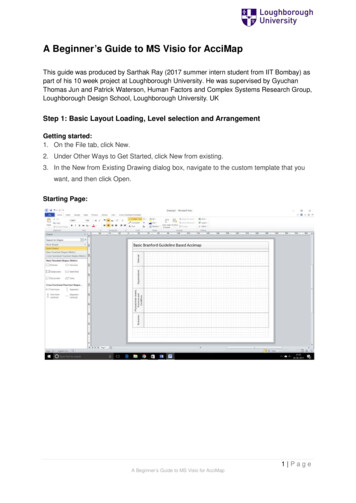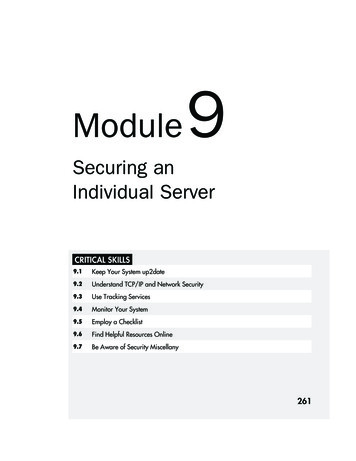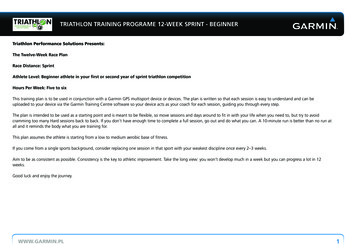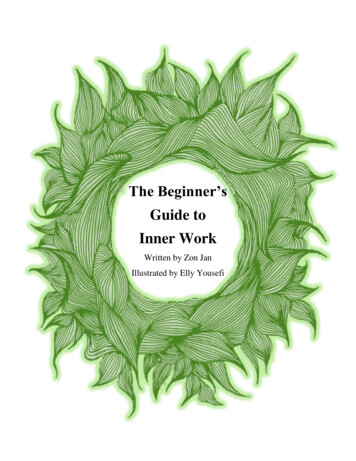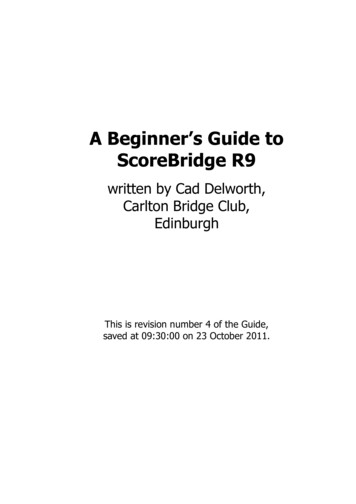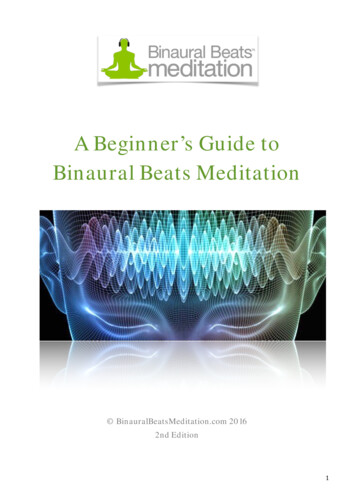
Transcription
A Beginner’s Guide toBinaural Beats Meditation BinauralBeatsMeditation.com 20162nd Edition1
Contents1.How Binaural Beats Work . 3The Brainwave Spectrum . 4A Natural Science . 5How to Test the Effects . 72.How to Use Binaural Beats . 11Best Practice Listening . 12Sitting Vs. Lying Down . 143.How to Choose the Right Headphones . 17Setting the Volume . 194.How Often to Listen . 215.Further Reading . 222
1.How Binaural Beats WorkGerman experimenter Heinrich Wilhelm Dove first discovered howbinaural beats work in 1839. It wasn’t until 1973, however, thatbiophysicist Doctor Gerald Oster brought the benefits into mainstreamawareness through an academic paper named Auditory Beats in theBrain (Scientific American, 1973).Oster’s research concluded that binaural beats could be an effective toolin cognitive and neurological research because of the way in thefrequencies altered brain state.Forty three years on, and a broad range of research by scientists andsound engineers later, binaural beats music is widely used bymeditators, therapists, hypnotists and individuals seeking to positivelychange self-limiting emotions and behaviors, relieve stress, improvememory and focus, increase productivity, and reach higher levels ofspiritual consciousness.3
The Brainwave SpectrumIn the same way that electrical equipment runs at specific frequencies,so does the brain. These frequencies are known as brainwaves and aremeasured in Hertz (Hz). When we are in high states of anxiety thespeed of our brainwaves increases, and when we are relaxed the speeddecreases. This concept is key in understanding how binaural beatswork.When the brain is in an awake and aware state, it is usually running atsomewhere between 5 – 40 Hz. When we are in a brain state conduciveto learning and energetic activity, our brainwaves run at around 20 –25 Hz; this is known as the Beta state.In states of deep meditation, our brainwaves will be running atsomewhere between 4 – 8 Hz, which is known as the Theta State. Indeep sleep, where the regenerative facilities of the body are inoperation, our brains run somewhere between 1 – 4 Hz, which is knownas the Delta state.4
A Natural ScienceThe science of binaural beats occurs naturally in the brain. A separatesound frequency – which sounds like a tone – is sent to the left andright ears through headphones.5
Upon hearing the two frequencies, the brain responds by interpretingthe two frequencies as one consistent, rhythmic sound frequency,known as a binaural beat(s).The resulting frequency (tone) represents the mathematical differencebetween the two frequencies (Hz) of the left and right tones that wereinitially sent to the left and right ears.For example: If the right ear is sent a tone of 200 Hz, and the left ear issent a tone of 205 Hz, the brain’s waves (brainwaves) automaticallybegin to vibrate at the difference between these two signals (e.g. 5 Hz).The technical term for this process is ‘frequency followingresponse’ (FFR).6
To simplify this explanation, we should think about this process assending a sound tone to the left ear and a sound tone to the right ear.Subsequently a new tone that trains (or “entrains”) the brain to the waywe want to feel is naturally produced by the brain.How to Test the EffectsYou can test the scientific theory by visiting our How it Works page andputting on headphones. Scroll down the page until you come to thesection that contains an audio player.First press play on the sample provided and listen awhile. Then take offone of your earphones (left or right). Notice how the consistent,pulsating tone is lost when one earphone is removed.Now swap ears and try the other side. When you listen individually toeach earphone, you hear the original sound frequency (tone) being sentto that ear. When you put the other earphone back on, the brainimmediately responds to the presence of both frequencies (tones) andeffectively creates a third sound frequency (tone), which is the binauralbeat(s).7
Binaural beats music is completely safe because the process simplyreplicates human brainwave states that occur within the brainwavespectrum on a daily basis.This means we can use binaural beats music to entrain the brain tostates conducive to health and wellbeing: such as deep meditation andrelaxation, productivity and focus and high-level learning andcreativity.For example, a person suffering from stress can listen to binaural beatsmusic that contains Theta waves. By doing so, the brainwaves will beentrained to a state of lower activity, therefore calming the mind andreleasing stress and leaving the listener more relaxed.8
9
Think of binaural beats like taking vitamin supplements to enhance thebrain’s performance. By using the appropriate recording in a specificsituation, the brain can be habitually trained to move into the desiredstate.For example, a person who suffers from anxiety before a particularevent, such as flying or interviewing for a job, could listen to arecording designed to relieve symptoms of anxiety beforehand to assistin creating a positive, habitual mental association.When entrained in this way over a prolonged period, the brain willnaturally begin to adopt this state in future occurrences of the sameevent.10
2.How to Use Binaural BeatsYou can use binaural beats music anywhere at anytime, as long as youhave headphones. The reason you need headphones is that the brainneeds to hear both tones (left and right) at the same time to producethe desired effect.Technically speaking, if you put your head between a set of speakers,you could listen without headphones. However, the effects would begreatly reduced – not to mention that this is an impractical way toenjoy the experience.11
The ‘frequency following response’ process is not location dependent,which means that generally speaking you can listen wherever you wantto.The process happens naturally when the brain receives the soundfrequencies to each ear, so it doesn’t matter whether you’re at home orat work. However, as with standard meditation practice, to achieveoptimum results, we recommend that you listen in a relaxedenvironment, free of distraction.The reason for this is because whether you are using binaural beats tomeditate, relax, improve concentration and focus, relieve stress or sleepbetter, the brain will respond best to entrainment when it is leastdistracted by external sounds and movement.Best Practice ListeningWhen listening to a recording for meditation or relaxation purposes,and for stress and anxiety relief, we particularly recommend that youfind an isolated space, ideally in a neutral environment that isn’tassociated with high-energy activity.12
Your environment should be free of disturbance, so be sure to turn offyour phone and let those likely to disturb you know that you will not beavailable for the duration.Sitting in close proximity to nature is ideal. You might choose to sit inthe park, by a lake or river, or an area surrounded by plants, flowersand trees. You might choose to sit in your garden, or, if you can’t gooutside, find a relaxing room in the house that benefits from plenty ofnatural light.Focus on being in the moment; present and relaxed. If you find thisdifficult, close your eyes and concentrate on the rise and fall of yourbreath as you listen. Visualise your breath coming and going from yourbody. Watch it flow in and consume your body, and then flow out as itconnects you with the natural world. The aim is to release your mindfrom the attachments of everyday life and allow the brain to centreitself for optimal entrainment.If you are listening to a recording designed for high-level concentration,heightened creativity, increased productivity or wakefulness, then by allmeans listen while you engage in the activity you wish to entrain thebrain for. This might include working at the computer, writing or13
painting. But again, the less distracted by outside influence (trafficnoise, people talking, etc.,) the more effective the entrainment will be.We advise that you sit or lie down rather than walking around. This ispurely for your own safety. The last thing we want is for you to have anaccident because you couldn’t hear what was going on around you, orbecause you were too relaxed or focussed to sense danger.Please Note: Never listen to binaural beats music while driving oroperating machinery.Sitting Vs. Lying DownBinaural beats music is commonly used by meditators, and by thoseseeking to attain higher levels of consciousness and spirituality. This isbecause the music enables the brain to move quickly into states of deeprelaxation – conducive to stimulating and opening the third eye. This,combined with ambient sounds that contain hypnotic-like properties,contribute to a state of deep concentration and mindful awareness ofthe present; thus the term binaural beats meditation.14
It is therefore quite common for users to assume the traditional seatedmeditation position, also known as the lotus position. If you find thisposition uncomfortable, don’t worry, it isn’t a necessity. You caninstead sit on a cushion or a comfortable seat. You can also lie down ona couch or on the floor.However, if you are likely to fall asleep, refrain from lying down,particularly on your bed, unless of course you are listening to Deep15
Sleep, in which case the purpose is exactly that. Whether you decide tosite, lie down or walk around, ensure you aren’t restricted by tightclothing, and that you aren’t too hot or too cold. The general rule is totry and make yourself as comfortable as possible.16
3.How to Choose the Right HeadphonesWhile any pair of standard earbuds – like those that come free withyour phone – will do the job, if you are using binaural beats music on aregular basis, it really is worth investing in some good qualityheadphones to get the most out of your experience.We recommend using closed-back headphones for an optimal listeningexperience, and where possible avoiding cheaper models that have poorfrequency response and cause reflections and resonance.17
If you aren’t aware of the difference between closed-back and openheadphones, here is a short explanation:Closed headphones have a sealed cup, whereas open headphones are“open” behind the driver. Basically this means that closed headphoneswill stop you hearing outside sounds, and stop sound leaking from yourheadphones into the earshot of others.In short, closed headphones tend to give you a more "in head"soundstage, which is great for listening to music in general.18
However, lower-end brands of closed-back headphones, despite havinga sealed cup, still present problems because they produce reflectionsand resonances, unlike higher-end models from the likes of Bose,Sennheiser, and Sony, which deal these issues very well.Amazon.com regularly has good deals on affordable, good qualityclosed-back headphones. We have also written an extensive post on thissubject to help you choose the right pair for your budget. Read that posthere.Setting the VolumeYou don’t want to give yourself earache, but at the same time you don’twant the music to be so low that you can hear external sounds. Whenlistening, set the volume so that you can’t be disturbed by outside noiselike passing traffic or people talking.Depending on the track you purchase from our store, you will find thatthe prominence of the binaural beats (the tone) underneath the musicvaries. This is because the frequencies used to create the binaural beatstrack (the pulsating tone underneath the music) differs for each brainstate in the spectrum (Delta/Theta/Alpha/Beta). For example, Astral19
Projection has a subtler binaural beats track than Zen Focus. Simplyadjust the volume of each recording to a level you are comfortable with.20
4.How Often to ListenBinaural beats are safe and there are no known side effects. However,from a legal standpoint we are unable to recommend our music topregnant women, those with a history of seizures, and those with heartproblems.In addition, we do not advocate excessive use, but purely as aprecaution. Consider that binaural beats meditation music is differentto standard music. While normal music does contain Theta, Beta andDelta frequencies within it’s soundscape; and we are exposed to thesefrequencies in nature every day, the frequencies aren’t delivered in sucha concentrated form. Therefore we advise moderate use to air on thesafe side of avoiding possible headaches caused by excessive headphoneuse.Listening on a daily basis is fine, but we suggest a limit of two to three30-minute recordings per day. We user test our music prior tocommercial release, and research has shown us that this level of useageis more than sufficient to bring about profound, positive change.21
5.Further ReadingIf you have found this guide useful and would like more information onbinaural beats and brainwave entrainment, you can join us over on ourblog where we regularly post up useful helpful tips and researchfindings.If you are interested in purchasing one or more of our meditations, youcan find out all you need to know under our FAQ section. Alternatively,if you have a question you’d like to ask us, you can contact us here.We hope you thoroughly enjoy our music and look forward to hearingfrom you soon.Best regards.Daniel Finch (founder).BinauralBeatsMeditation.com22
Copyright NoticeAll rights reserved. BinauralBeatsMeditation.com 2016. No part of this guidemay be reproduced, distributed, or transmitted in any form or by any means,including photocopying, recording, or other electronic or mechanical methods,without the prior written permission of the publisher, except in the case of briefquotations embodied in critical reviews and certain other non-commercial usespermitted by copyright law.23
In states of deep meditation, our brainwaves will be running at somewhere between 4 – 8 Hz, which is known as the Theta State. In deep sleep, where the regenerative facilities of the body are in operation, our brains run somew
